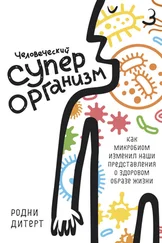A. Naseribafrouei et al., “Correlation Between the Human Fecal Microbiota and Depression,” Neurogastroenterology and Motility: The Official Journal of the European Gastrointestinal Motility Society 26, no. 8 (August 2014): 1155–62.
G. A. Rook, C. L. Raison, and C. A. Lowry, “Microbiota, Immunoregulatory Old Friends and Psychiatric Disorders,” Advances in Experimental Medicine and Biology 817 (2014): 319–56.
D. W. Kang et al., “Reduced Incidence of Prevotella and Other Fermenters in Intestinal Microflora of Autistic Children,” PLoS One 8, no. 7 (2013): e68322.
Hsiao et al., “Microbiota Modulate Behavioral and Physiological Abnormalities Associated with Neurodevelopmental Disorders.”
Vijay-Kumar et al., “Metabolic Syndrome and Altered Gut Microbiota in Mice Lacking Tolllike Receptor 5.”
P. Bercik et al., “The Intestinal Microbiota Affect Central Levels of Brain-Derived Neurotropic Factor and Behavior in Mice,” Gastroenterology 141, no. 2 (August 2011): 599–609, 609 e1–3.
R. Diaz Heijtz et al., “Normal Gut Microbiota Modulates Brain Development and Behavior,” Proceedings of the National Academy of Sciences of the United States of America 108, no. 7 (February 15, 2011): 3047–52.
C. L. Ohland et al., “Effects of Lactobacillus Helveticus on Murine Behavior Are Dependent on Diet and Genotype and Correlate with Alterations in the Gut Microbiome,” Psychoneuroendocrinology 38 (2013): 1738–47.
A. R. Mackos et al., “Probiotic Lactobacillus Reuteri Attenuates the Stressor-Enhanced Sensitivity of Citrobacter Rodentium Infection,” Infection and Immunity 81, no. 9 (September 2013): 3253–63.
P. A. Kantak, D. N. Bobrow, and J. G. Nyby, “Obsessive-Compulsive-like Behaviors in House Mice Are Attenuated by a Probiotic (Lactobacillus Rhamnosus GG),” Behavioural Pharmacology 25, no. 1 (February 2014): 71–79.
Hsiao et al., “Microbiota Modulate Behavioral and Physiological Abnormalities Associated with Neurodevelopmental Disorders.”
S. Guandalini et al., “VSL#3 Improves Symptoms in Children with Irritable Bowel Syndrome: A Multicenter, Randomized, Placebo-Controlled, DoubleBlind, Crossover Study,” Journal of Pediatric Gastroenterology and Nutrition 51, no. 1 (July 2010): 24–30.
M. Dapoigny et al., “Efficacy and Safety Profile of LCR35 Complete Freeze-Dried Culture in Irritable Bowel Syndrome: A Randomized, Double-Blind Study,” World Journal of Gastroenterology 18, no. 17 (May 7, 2012): 2067–75.
E. Smecuol et al., “Exploratory, Randomized, Double-Blind, Placebo-Controlled Study on the Effects of Bifidobacterium Infantis Natren Life Start Strain Super Strain in Active Celiac Disease,” Journal of Clinical Gastroenterology 47, no. 2 (February 2013): 139–47.
M. Fr mont et al., “HighThroughput 16S rRNA Gene Sequencing Reveals Alterations of Intestinal Microbiota in Myalgic Encephalomyelitis/ Chronic Fatigue Syndrome Patients,” Anaerobe 22 (August 2013): 50–56.
M. Messaoudi et al., “Beneficial Psychological Effects of a Probiotic Formulation (Lactobacillus Helveticus R0052 and Bifidobacterium Longum R0175) in Healthy Human Volunteers,” Gut Microbes 2, no. 4 (July/August 2011): 256–61.
Medical Council, General Board of Health, Report of the Committee for Scientific Inquiries in Relation to the Cholera-Epidemic of 1854 (London, England, 1855).
C. A. Lozupone et al., “Diversity, Stability and Resilience of the Human Gut Microbiota,” Nature 489, no. 7415 (September 13, 2012): 220–30.
S. H. Duncan et al., “Contribution of Acetate to Butyrate Formation by Human Faecal Bacteria,” British Journal of Nutrition 91 (2004): 915–23.
World Gastroenterology Organisation, World Gastroenterology Organisation Practice Guideline: Probiotics and Prebiotics (May 2008). www.worldgastroenterology.org/assets/downloads/en/pdf/guidelines/19_probiotics_prebiotics.pdf.
Чтобы вы могли получить представление о результатах клинических испытаний: в перекрестном, плацебоконтролируемом, двойном слепом исследовании потребление 30 граммов в день пребиотика под названием изомальт (смесь полиолов 1-О-Dглюкопиранозила-D-маннитола и 6-О-D-глюкопиранозила-Dсорбитаола) в течение четырех недель привело к увеличению доли бифидобактерий на 65 процентов и увеличению общего количества их клеток на 47 процентов по сравнению с потреблением сахарозы. Другими словами, этот пребиотик увеличил количество представителей вида бактерий, который считается полезным, хотя прямое его воздействие на функции кишечника не изучалось. В другом исследовании, где двенадцать добровольцев принимали по 10 граммов инулина в день в течение шестнадцати дней, доля бактерий вида Bifidobacterium adolescentis увеличилась с 0,89 до 3,9 процента от общего количества микробов по сравнению с контрольным периодом без каких-либо пищевых добавок. A. Gostner, “Effect of Isomalt Consumption on Faecal Microflora and Colonic Metabolism in Healthy Volunteers,” British Journal of Nutrition 95, no. 1 (January 2006): 40–50; C. Ramirez-Farias et al., “Effect of Inulin on the Human Gut Microbiota: Stimulation of Bifidobacterium Adolescentis and Faecalibacterium Prausnitzii,” British Journal of Nutrition 101, no. 4 (February 2009): 541–50.
H. Steed et al., “Clinical Trial: The Microbiological and Immunological Effects of Synbiotic Consumption – A Randomized Double-Blind Placebo-Controlled Study in Active Crohn’s Disease,” Alimentary Pharmacology & Therapeutics 32, no. 7 (October 2010): 872–83.
D. Linetzky Waitzberg, “Microbiota Benefits After Inulin and Partially Hydrolized Guar Gum Supplementation: A Randomized Clinical Trial in Constipated Women,” Nutricion Hospitalaria 27, no. 1 (January/February 2012): 123–29.
Z. Asemi et al., “Effects of Synbiotic Food Consumption on Metabolic Status of Diabetic Patients: A Double-Blind Randomized Crossover Controlled Clinical Trial,” Clinical Nutrition 33, no. 2 (April 2014): 198–203.
J. A. Applegate et al., “Systematic Review of Probiotics for the Treatment of Community-Acquired Acute Diarrhea in Children,” supplement 3, BMC Public Health 13 (2013): S16.
Читать дальше
Конец ознакомительного отрывка
Купить книгу






![Анна Мохова - Ты не одна [Как забыть одиночество и найти счастье внутри себя] [litres]](/books/395417/anna-mohova-ty-ne-odna-kak-zabyt-odinochestvo-i-n-thumb.webp)





